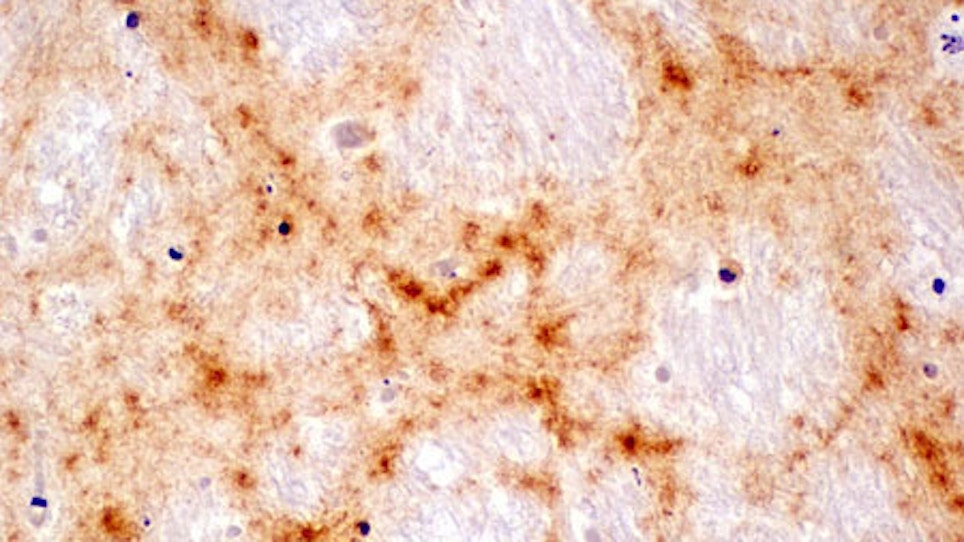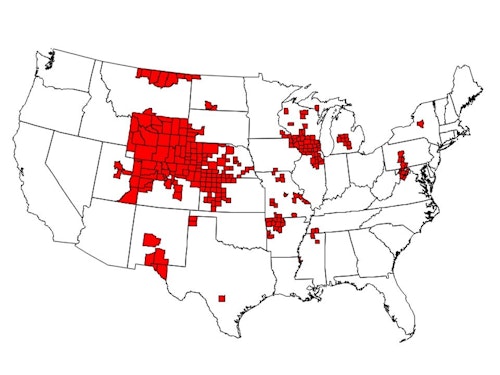
Prion protein aggregates (brown) in the brain of a mouse expressing the human-elk protein. Photo: UC San Diego Health
Last summer Grand View Outdoors reported that the Center for Disease Control and Prevention (CDC) was not ready to declare human resistance to Chronic Wasting Disease (CWD), while recent research indicated the disease affecting cervids will not spread to humans. Now FOX News is reporting, “Deadly ‘Zombie’ Deer Disease Could Possibly Spread to Humans, Experts Warn.”
The report cites experts from the University of Minnesota including Michael Osterholm, the director of the Center for Infectious Disease Research and Policy at the University of Minnesota. Osterholm, speaking at the Minnesota State Capitol last week, told lawmakers, “it is probable that human cases of CWD associated with the consumption of contaminated meat will be documented in the years ahead. It is possible that number of human cases will be substantial and will not be isolated events,” he says, according to the Twin Cities Pioneer Press.
But in 2015 the University of California San Diego published research in the Journal of Clinical Investigation that offers a conflicting view. The study revealed a small loop in the human prion that prevents corruption when exposed to elk prions. Given that CWD is a prion disease, these findings could be transformative.
“Since the loop has been found to be a key segment in prion protein aggregation, this site could be targeted for the development of new therapeutics designed to block prion conversions,” says Christine Sigurdson, DVM, PhD, associate professor of UC San Diego and UC Davis and senior author of the study.
In a related press release posted to UC San Diego Health’s newsroom, prions are described as protein aggregates. They are not microorganisms like bacteria and viruses. “Some protein diseases are caused by an inherited genetic mutation, while others are caused by exposure to infectious prions in food. Acquired protein diseases are triggered when a foreign, misfolded prion protein causes the body’s own natural prion proteins to misfold and aggregate.”
“We suspected that a loop in the human prion protein structure may block the elk prions from binding, as the sequences did not appear to be compatible,” Sigurdson says.
The CDC’s published statement on CWD cites the recommendation of the World Health Organization:
Since 1997, the World Health Organization has recommended that it is important to keep the agents of all known prion diseases from entering the human food chain.
There have been no reported cases of CWD infection in people. However the CDC statement points to animal studies which suggest CWD poses a risk to some types of non-human primates like monkeys that eat meat from CWD-infected animals or come in contact with brain or body fluids from infected deer or elk.
About CWD
As of January 2019, CWD in free-ranging deer, elk and/or moose has been reported in at least 24 states in the continental United States, as well as two provinces in Canada. In addition, CWD has been reported in reindeer and moose in Norway and Finland, and a small number of imported cases have been reported in South Korea. The disease has also been found in farmed deer and elk.
Chronic Wasting Disease Among Free-Ranging Cervids by County, United States, January 2019

Nationwide, the overall occurrence of CWD in free-ranging deer and elk is relatively low. However, in several locations where the disease is established, infection rates may exceed 10 percent (one in 10), and localized infection rates of more than 25 percent (one in four) have been reported. The infection rates among some captive deer can be much higher, with a rate of 79 percent (nearly four in five) reported from at least one captive herd.
To learn more about CWD and how the disease impacts U.S. deer, elk and moose herds, go to CWD Frequently Asked Questions.





